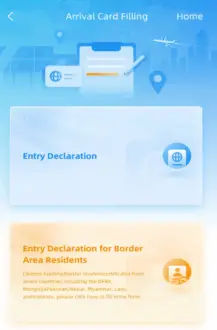
Update Date: November 20, 2025
On November 20, 2025, China’s National Immigration Administration (NIA) launched an official option for foreign nationals to complete their arrival (entry) card online before arriving at Chinese ports of entry.
The new digital filing channels include the NIA official website, government service portals, the “移民局12367” mobile app, and WeChat and Alipay mini-programs.

Travelers can also scan a QR code at the port or use self-service kiosks if they have not finished online filing in advance.
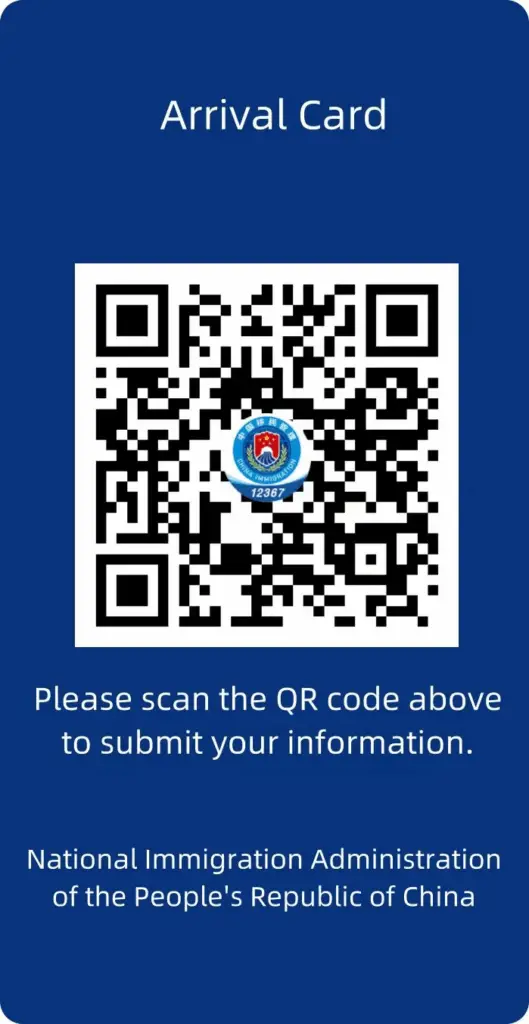
The change is intended to streamline arrival procedures, reduce time spent filling paper forms at arrivals, and support a more digital, traveler-friendly entry process.
Paper entry cards remain available for those who prefer or need to use them.
Who is eligible and who is exempt
Eligible travelers
All foreign nationals entering mainland China who previously would have been required to complete a paper arrival/entry card are eligible to use the online filing system.
This includes:
- Tourists.
- Business travelers.
- Students.
- Family visitors, and most categories of visa holders.
Exemptions — seven main categories
Seven categories of foreign nationals are explicitly exempt from submitting an entry card:
- Holders of China’s Foreigner’s Permanent Residence ID Card.
- Non-Chinese nationals with a Mainland Travel Permit for Hong Kong and Macao.
- Group visa holders or travelers covered by group visa waiver programs.
- Those transiting through China within 24 hours without leaving the port area.
- Cruise passengers returning on the same ship.
- Participants in fast-track immigration programs.
- Foreign crew on international transportation vehicles.
If you belong to one of these categories, you do not need to fill either an online or paper entry card.
Confirm your status before travel to avoid unnecessary steps.
Why use the online arrival card
Benefits for travelers
- Faster processing at arrival: completing the card in advance reduces time at immigration counters.
- Fewer errors: the online form often includes validation for required fields, which lowers the chance of incomplete or illegible responses.
- Multiple platforms: fill via website, mobile app, or mini-program — convenient for users with different preferences.
- Flexibility at arrival: if you don’t finish online, you can still scan a QR code at the port or use kiosks.
Benefits for authorities and airports
- Reduced queues and paperwork at busy ports of entry.
- Better data accuracy and digitized records that can speed up immigration checks.
- Improved contactless processing options, supporting health and safety protocols where needed.
Step-by-step guide: filling the China online arrival card
Step 1: Prepare documents and information
Before you start, have the following ready:
- Passport biographic page (passport number, nationality, full name as in passport).
- Flight details (airline, flight number, arrival airport, arrival date and time).
- China address while in-country (hotel, host address, or first place of stay).
- Contact details (email, phone number).
- Visa details if applicable (visa type, visa number, date of issue).



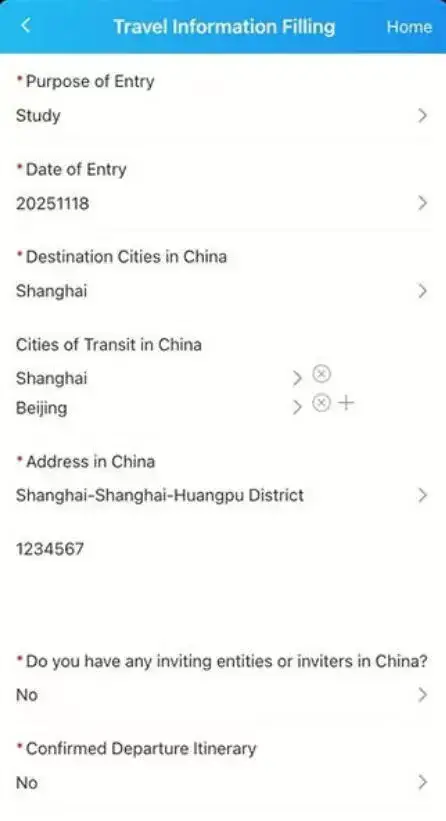

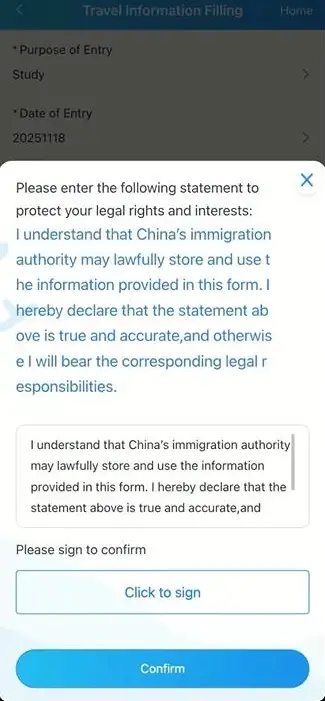
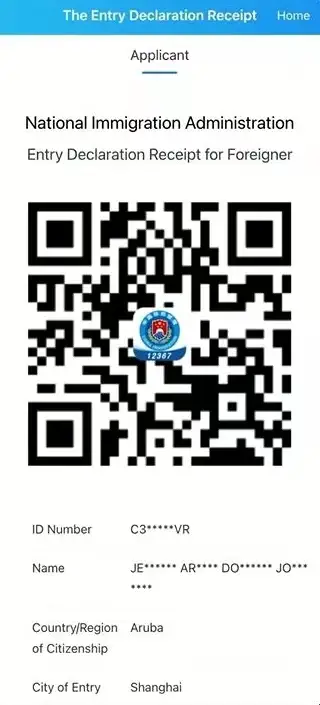
Step 2: Choose the filing channel
You can submit your arrival card through one of these channels:
- NIA official arrival card filing webpage (desktop or mobile browser).
- “移民局12367” official mobile app.
- Government service platforms integrated with NIA services.
- WeChat mini-program (search for NIA arrival card service).
- Alipay mini-program (search for NIA arrival card service).
- QR code scanning at the port (if you didn’t file in advance).
- Self-service kiosks at the port (paperless submission upon arrival).
Pick the channel that is most convenient for you. For most travelers, the mobile app or WeChat mini-program offers the quickest access.
Step 3: Fill out the form carefully
Typical fields include:
- Personal details: full name, gender, date of birth, nationality, passport number, passport expiry date.
- Travel details: arrival date, airline/flight number, point of entry (airport/port).
- Accommodation in China: hotel name and address or host’s address and phone.
- Purpose of visit: tourism, business, study, family visit, transit, other.
- Contact details: phone number and email address.
- Health/declaration items if prompted (depends on prevailing policies).
Double-check spelling against your passport, and ensure passport numbers and dates are accurate.
Step 4: Submit and save confirmation
After submitting:
- Save or screenshot the confirmation page or QR code if one is provided.
- If the system issues a digital QR code or confirmation number, you can present that at immigration or at kiosks. Most systems will generate a scannable code for faster recognition.
Step 5: Present at arrival
At the port you may:
- Present the QR code on your phone to immigration or scan at self-service gates.
- Proceed to manual review if instructed by immigration staff.
If you did not file in advance, scan the on-site QR code or use kiosks to complete the digital submission, or fill a paper arrival card.
Common questions and troubleshooting
Q: What if the online system is unavailable?
If the online filing portal or app is temporarily down, you can:
- Use the on-site QR code scanning process at arrival.
- Fill a paper entry card at the port.
- Use a self-service kiosk at the port if available.
Always allow extra time if you suspect technical issues.
Q: What if I entered incorrect information?
If you notice a mistake after submission:
- If you are still before arrival, re-open the portal/app and see if the system allows edits or re-submission; some systems permit updating before final validation.
- If you have already arrived and the mistake affects immigration checks (e.g., passport number), inform immigration staff at your port of entry and follow their instructions.
Q: Can multiple travelers use one device?
Yes. Family members or groups can complete individual entries on the same device or separate devices, but each traveler must submit their own information unless specifically allowed by group visa rules.
Q: Is data stored and how long?
Data handling and retention policies are managed by the NIA and relevant government platforms. If you need specifics (retention period, deletion requests), consult the NIA’s official guidance or privacy statement on their website.
Q: What languages are supported?
The online filing interface typically supports Chinese and English.
Table: Comparison of filing channels
| Channel | When to use | Accessibility | Tips |
|---|---|---|---|
| NIA official website | Before departure; desktop users | High; works on browsers | Best for travelers who prefer a full-screen interface |
| 移民局12367 mobile app | Before departure; on-the-go filing | High; iOS and Android | Install and test ahead of travel; enable notifications |
| WeChat mini-program | Before departure; popular in China | High for WeChat users | Search mini-programs inside WeChat; convenient for frequent visitors |
| Alipay mini-program | Before departure; Alipay users | High for Alipay users | Useful if you already use Alipay services |
| QR code at port | If unable to file in advance | Immediate on arrival | Scan and complete on arrival; ensure mobile data or airport Wi‑Fi |
| Self-service kiosk | If you prefer in-person digital filing | Available at many major ports | Helpful for travelers without smartphones or with connectivity issues |
| Paper entry card | Backup option on arrival | Universal | Keep a pen; rules unchanged for exemptions |
Sources: NIA official page; NIA mobile app listings; travel advisory summaries.
Fast-track and special programs
Fast-track immigration programs
Some airports and ports offer fast-track immigration lanes or trusted traveler programs.
Participants in those programs may be exempt from arrival card submission or have simplified procedures.
Check eligibility and enrollment instructions for the specific port you plan to use.
Group visa and group travel arrangements
Group visa holders and travelers under group visa waiver programs are usually exempt from individual arrival card submissions.
Tour operators typically handle collective documentation; confirm with your tour operator.
Privacy and data security considerations
- Only provide required fields; avoid adding unnecessary personal or sensitive information beyond what the form requests.
- Use official channels: the NIA official website, the “移民局12367” app, and recognized government mini-programs. Beware of unofficial third-party websites claiming to help file entry cards.
- Save confirmations on your device in case immigration asks to see proof of submission.
- If using public Wi‑Fi to file, consider turning off automatic file sharing and ensuring your device has current security patches.
Practical travel tips
Before you travel
- Fill the arrival card online as soon as you have stable travel and accommodation details.
- Keep a digital and printed copy of the confirmation.
- If you travel frequently to China, save a template of your address in China and emergency contacts to speed future submissions.
At the airport
- Keep your passport and arrival card confirmation accessible.
- Allow extra time if you are unfamiliar with the port’s layout or if you travel during peak hours.
- If using a kiosk, follow on-screen prompts carefully and print a receipt if available.
For families and groups
- Complete individual entries for each traveler unless your group is covered by a group exemption.
- For children listed in parents’ passports, follow the specific rules: some systems require a separate entry card for each minor depending on immigration rules.
Scenarios and examples
Example 1: Tourist completing online filing
- Anna from Germany is flying to Shanghai for a 10-day trip.
- She opens the NIA mini-program in WeChat two days before departure, fills in her passport and flight details, and submits.
- She gets a QR confirmation and screenshots it.
- On arrival, she scans at a self-service gate and proceeds through immigration faster than travelers waiting to fill paper cards.
Example 2: Business traveler with last-minute change
- Sam from Australia has a flight rerouted and lands at a different Chinese airport than planned.
- He uses the on-site QR code at arrival to submit his arrival card and presents the QR to immigration.
- If any details differ from his initial online submission, he notifies immigration staff for guidance.
Example 3: Transit passenger exempted
Liam has a 12-hour transit through Guangzhou and stays in the transit area. Because he does not leave the port area within 24 hours, he is exempt from submitting an arrival card.
Integration with other entry requirements
Filing an online arrival card does not replace visa or other entry requirements.
You must still:
- Hold a valid passport and visa if required by your nationality.
- Present other documents as requested (invitation letters, business credentials, student documents, etc.).
- Comply with health, customs, and other port-level checks.
Check visa requirements for your nationality and the region of China you will enter before traveling.
Accessibility and support
If you need help:
- Use the help or FAQ sections in the “移民局12367” app or the NIA website.
- Airport information desks often assist with kiosk use or QR scanning.
- Consulates or embassies can provide country-specific travel advice but generally do not handle arrival card submissions.
What to watch for going forward
- Expect continued digital refinements to the arrival card process as authorities gather user feedback and improve system stability and language support.
- Additional ports may roll out self-service kiosks or expand QR-based procedures.
- Policy or form fields may temporarily change in response to public health or security considerations; always check official notices close to travel dates.
Quick checklist before departure
- Passport valid for intended stay.
- Visa (if applicable) valid and accessible.
- Online arrival card filed or screenshot confirmation saved.
- Hotel/host address ready and accurate.
- Flight and contact details ready.
- Backup: understand where kiosks and QR codes are located at your arrival port.
Table: Quick comparison of submission timing and convenience
| Submission timing | Convenience level | Suitable for |
|---|---|---|
| 48+ hours before arrival | Very high | Leisure travelers, business travelers with fixed plans |
| 24–48 hours before | High | Most travelers |
| Day of travel pre-arrival | Medium | Last-minute filers with internet access |
| On arrival via QR/kiosk | Medium | Those who could not file earlier |
| Paper at arrival | Low | Connectivity issues; preference for paper |
Sources: NIA official announcement and platform rollout information.
External links and resources
- NIA arrival card filing portal: https://s.nia.gov.cn/ArrivalCardFillingPC/
- 移民局12367 mobile app (search in your app store for “移民局12367”)
- WeChat mini-programs (search within WeChat for NIA arrival card services)
- Alipay mini-programs (search within Alipay for NIA arrival card services)
- China National Immigration Administration: https://www.nia.gov.cn
Final notes
The move to an online arrival card is a practical, traveler-focused update that reduces paperwork and helps speed arrivals for most foreign nationals.
Use official channels, prepare your documents ahead of time, and keep a copy of your confirmation for a smoother entry experience.


